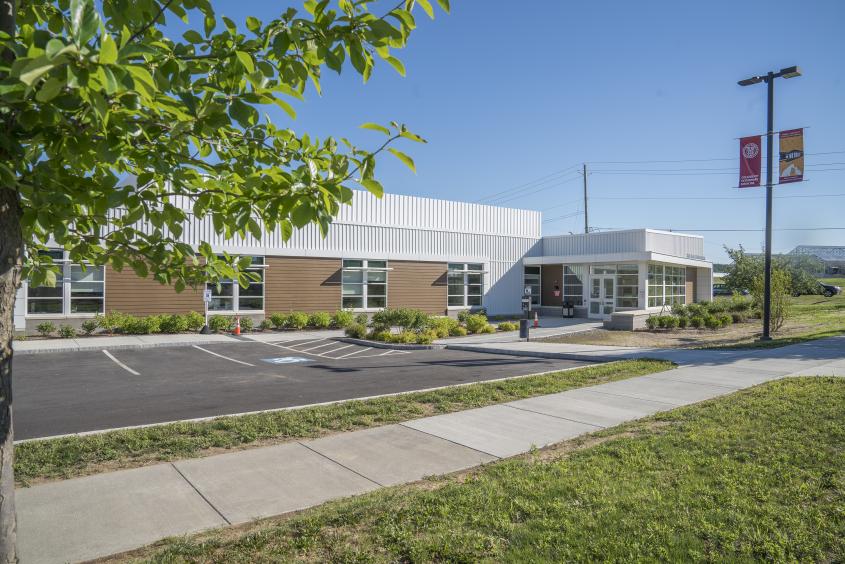Technology and care combine at Cornell’s new Small Animal Community Practice
Buying inventory, keeping the books, managing staff – there’s a lot that goes into running an independent veterinary clinic besides treating sick animals. Now, students at the College of Veterinary Medicine will experience these aspects first-hand with the opening of the college’s new Small Animal Community Practice.
The SACP opened its doors to patients this month and will function much like a neighborhood small animal practice. Fourth-year DVM students will step into the role of veterinarian to perform treatments ranging from vaccinations to routine surgeries like mass removals to dental procedures, all with guidance from experienced faculty and licensed veterinary technicians. With the opening of the SACP, the college also implemented a new, commercial electronic medical record system that will offer better customer service for clients, provide visibility into practice management and make patient care more efficient for students and staff.
Community building
Local architects worked with the veterinary architecture firm BDA Architecture to design the new 10,000 square foot building on Campus Road, which marks the final addition under the class expansion project. Though the building was constructed within the past year, the clinic has been under discussion for far longer, with the initial vision coming from Dr. Lorin Warnick, Ph.D. ’94, the Austin O. Hooey Dean of Veterinary Medicine. “We recognized there was a gap in the veterinary education,” says Warnick. “While our students were getting excellent training in specialty clinical skills, we also wanted to prepare them for the day-to-day challenges of running an independent general practice. This new clinic will do just that, blending entrepreneurial education with hands-on clinical training.”
CVM has a long history of teaching primary veterinary care to both small and large animals, which involves prevention, herd health, sick animal care, care for aging pets, and referrals to specialists. The Small Animal Community Practice evolved from the Community Practice Service, a program that originated about three decades ago under William Hornbuckle, the Rudolph J. and Katherine L. Steffen Professor of Veterinary Medicine, emeritus. CPS has a long-established educational value, with Hornbuckle and many other faculty members receiving teaching excellence awards over the years.
Maddie's® Shelter Medicine Program at Cornell and the primary care surgery program will also share the building. “The combining of these three programs together will provide synergy for future community engagement,” says Dr. Meg Thompson, associate dean of hospital operations and corporate relations and the director of the Cornell University Hospital for Animals.
 Students take initiative
Students take initiative
The Community Practice Service previously operated within CUHA, but it had begun to outgrow its former home, and the faculty and staff are excited to welcome patients to the new, standalone building. “We’re like your family veterinary hospital, where people bring their pets for most of the care that they need in their lives,” says Dr. Brian Collins, Small Animal Community Practice section chief. “We want to offer state-of-the-art care using the newest information technology and equipment, so that we can teach the students the gold standard whenever possible, but we want to do it in a very real setting with clients from the community.”
The SACP has five exam rooms, which doubles its previous capacity, a treatment room, and an area for hospitalizing the animals. The addition of two dental workstations means that the practice can now offer dental services, including cleaning, X-rays, and surgical tooth extractions. It is a feline-friendly clinic, with separate waiting areas for dogs and cats and feline-friendly cages. The clinic also has its own surgery and X-ray facilities, which will make scheduling procedures easier.
The independent building is likely to yield more independent students. While at CUHA, it was easy for students to consult specialists on routine cases, says Dr. Leni Kaplan, a lecturer for Small Animal Community Practice. “They’re not always going to have a specialist just down the corridor. Students are really going to have to stand on their own two feet and decide what to do with patients.”
Even the design of the building is optimized to give students a range of experiences. The exam rooms display the computer monitor in different places, and contain a variety of exam tables that students will likely encounter in future workplaces. The surgery rooms feature different types of lights, and the hospital has multiple types of cages, which differ from the ones used at CUHA.
Students also will gain an appreciation for the realities of running a clinic as a small business. “Our goal is to expose them to the practice management side, including finances and pricing, reinvesting in the business, human resources, and how to communicate with staff,” says Kaplan. Students will be involved with billing, building maintenance, and keeping track of cash flow – all skills that factor into running a successful veterinary clinic.
Client-friendly tech
With the new clinic also comes new software for managing electronic patient records. The new system reflects what veterinarians use in their own practices, rather than a system designed for a large teaching hospital. While the previous system for tracking patients was cutting-edge when it was deployed in 2006, it now feels bulky and inefficient compared to modern services.
Daniela Mancuso, the project manager for clinical and business workflows at CUHA, worked with staff and faculty at the hospital to audition and select the new software. Ultimately, they decided on ezyVet, a New Zealand-based company that designs cloud-based veterinary software that students are likely to encounter in future clinics. The group also chose to integrate two additional software products, one for managing referrals and a second for veterinary patient management that will help clinicians to plan, time, and document patient treatments more efficiently. The software also enables the use of machine learning and AI to create and automate workflows, while still allowing faculty and staff to oversee student work. “We keep finding all these processes that we used to do manually, but now will be automatic, so it’s changing our workflow tremendously,” says Mancuso.
In the future, SACP will roll out additional features to improve customer service, such as a kiosk for checking in at appointments, a patient portal for viewing medical records, online appointment booking, and confirmations through text message.
Next, Mancuso’s team will begin tailoring the software for CUHA and the various specialty practices. They hope to roll out the software hospital-wide in late fall.
-By Patricia Waldron
Video tour of the new Small Animal Community Practice






